Who Is Fernando Torres?
Fernando Torres, in his career as a player, was managed by several coaches with a fairly similar and straightforward idea, always wanting to play with a lot of verticality and with a preference for defending lower rather than high, where he triumphed greatly since he was always an excellent striker to look for support with little touches and then create diagonal runs into space so that they could throw through passes to those areas.
At 38 years old, the legendary striker for Liverpool, Spain and Atlético Madrid embarked on a career as a coach back in 2021, with Atlético de Madrid U19, which has found many similarities to Diego Simeone’s team, in addition to what we saw in the teams that Fernando Torres played in during his playing career.
The ex-Chelsea man won his group in the youth category in his first campaign and is now off to an excellent start in the Youth League, with five victories and one defeat in the group stage.
With quite clear, vertical, and interesting ideas, ‘El Niño’, as he is commonly known, has begun to set out on a path as a head coach that will surely lead him to first-division football.
That is why we will carry out a tactical analysis
of his tactics at Atlético de Madrid U19 andan analysis of the team in both phases of the game.
Fernando Torres Tactics – Low Block
Fernando Torres has adopted in his defensive search for a shape almost always within a 5-3-2 that covers many central and outer spaces with his back-five, in addition to an incredibly hard-working midfield three, which covers spaces in a great way, and they move the block side-to-side smartly.
The defensive line’s positioning is not high, despite the fact that on certain occasions, they can put pressure on the rival third.
However, it is something very short, and they always prefer to be more zonal and compact with their 5-3-2, which can sometimes become a 5-2-3.
The idea is to give the ball back to the rival and stress them to the maximum so that they cannot progress through any channel on the pitch.
Normally we see the team standing a few meters from their box, although sometimes they can also give the entire field to the first rival passers so that they can be placed in a high block without spaces to act, and many players in the Spanish side forewarned to win the possession back and throw balls into space which they do great and generate a lot of damage to opponents through that attacking pattern.
It is an approach quite similar to what Simeone does and has sought in Atlético de Madrid in recent years.
Not only in the shape that has been changing throughout his seasons at the club, but also in what we can see as the positioning, the hard work of the midfield and the smart movements to block different channels where opponents can receive between the lines.
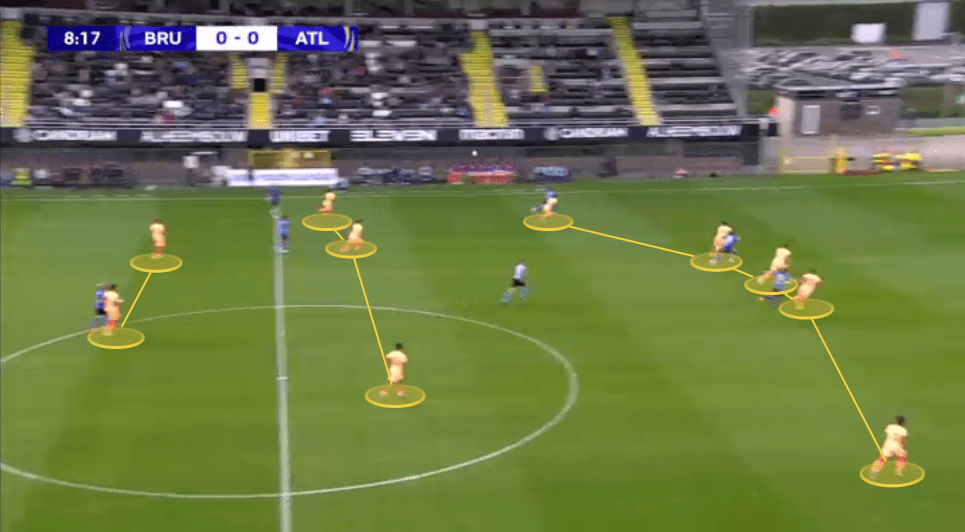
Despite the fact that these types of defensive ideas are zonal and have little to tell apart from closing the spaces on the field with their further back positioning, there are still certain micro-details to see that make this system work.
For example, the midfielders are vital when the opposition wants to play the ball to the outside.
Every time teams face Torres’ Atletico, many look to generate football through the wide channels, whereas the Spanish team looks to reverse it, generating defensive triangles with the wing-back, centre-back and midfielder on that side, concentrated, covering, avoiding 2v1/3v2 situations and taking spaces that are left after the rival’s constant movements trying to open up pockets of spaces.
One of the important things about these triangles is that this midfielder will continue to cover players who want to activate in the half-space and seek to penetrate the penalty area with their runs, but these spaces that they leave are taken by #6, and the block moves quite fast to cover these holes that can be key for the opponent.
When you want to play that back in your third, you have to be committed and attentive to move and cover every zone you are responsible for.
It’s a work of attitude and concentration.
As a #6, for example, you are one of the players who makes the most coverings during the match.
For example, if the wing-back jumps to steal and chase the wide opponent, he will look to force him to restart the play.
So one of the opposing players will try to grab the wing-back’s back, and the midfielder on that side will go with him.
This calls for the #6 to action, which approaches regularly for the team.
If not, the centre-back will appear to cover forward or to the side.
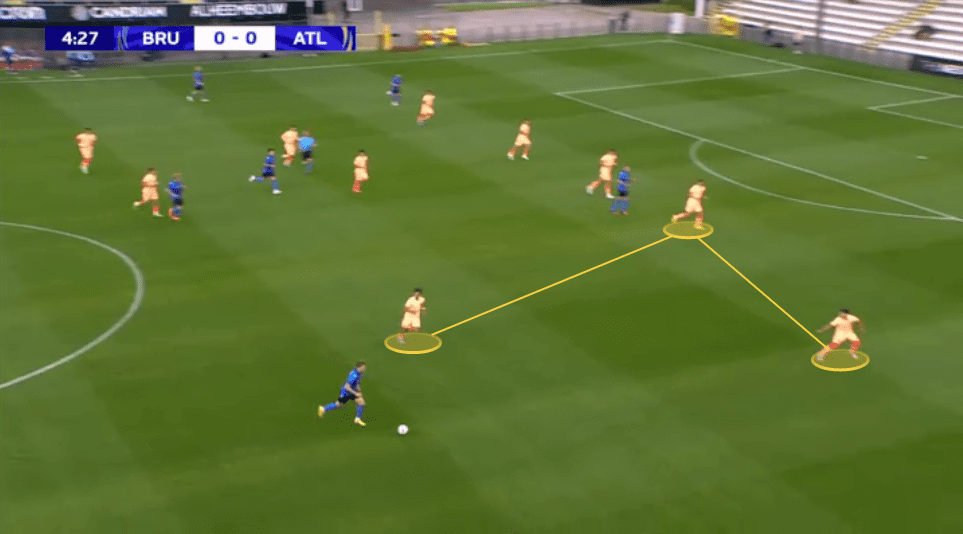
Although it may seem extremely easy, some teams are disastrous when defending in a zonal approach, and it is because of these details.
Covering, positioning and concentration of the player do not happen in the best way.
As long as teamwork and effort exist on the pitch, in addition to constant tactical work, the mid-and low blocks will be extremely compact, and ‘El Niño’ has already achieved this in his team.
Drawing Pressure and being vertical
In possession of the ball, the principles of Fernando Torres formations are quite interesting.
Despite being quite vertical and usually avoiding long possessions, he has transformed the team to adapt to different contexts, with clear principles that can be clearly seen in their matches.
One of the first that we can see is how they seek to attract in the first line of passing, touching the ball from side to side to control the spaces on the field to later generate some dismarking movements with the players above to run into space and wait for a through ball or a reception between the lines, something that is used a lot.
One of the things that differentiate Torres’s vertical ideas from the common ones we see on a day-to-day basis in direct play is that he avoids the long ball.
He seeks more to attack in a faster way but plays on the ground.
Although he does not eliminate it completely, his idea is not to omit and go to the opponent’s own third, but to be direct, going through each of the thirds before creating a chance.
It is common to see a pass from a central defender to a winger or player in half-space, who then throws a ball into space to eventually score.
The most played passes to space are from the inside to the outside.
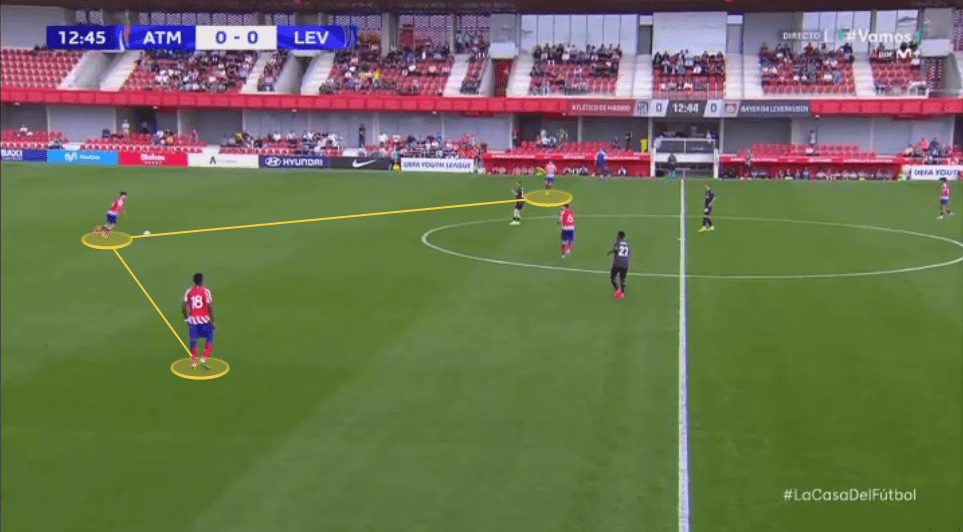
‘El Niño’ has recently managed two ways of attacking when they have the ball: with a back-three and a back-four.
We are going to first analyse the back-three, which handles similarities when playing with four defenders in possession, such as the width with which they seek to generate plays on the first passes.
With three defenders behind, Atlético places two midfielders in front and another five in the attack.
They try to cover all the channels on the field, loading the attacking line heavily.
Wingers, attacking midfielders, and wing-backs constantly move downward and diagonally into space, especially their centre-forward, Abde Raihani, who is very reminiscent of Torres in his days.
The ball moves from side to side during the first stages.
They look to attract the rival team and wait for the exact moment and movement to launch the through-ball.
The central defenders, like almost all the squad players, have great technique and are responsible for progressing.
While they wait for that pass between the lines/into space to take place, the movement is slow.
Defenders touch the ball several times until the moment and movement arrives and the timing is perfect.
The execution takes tremendous speed and they constantly find free players to reach the last third in a very short time.
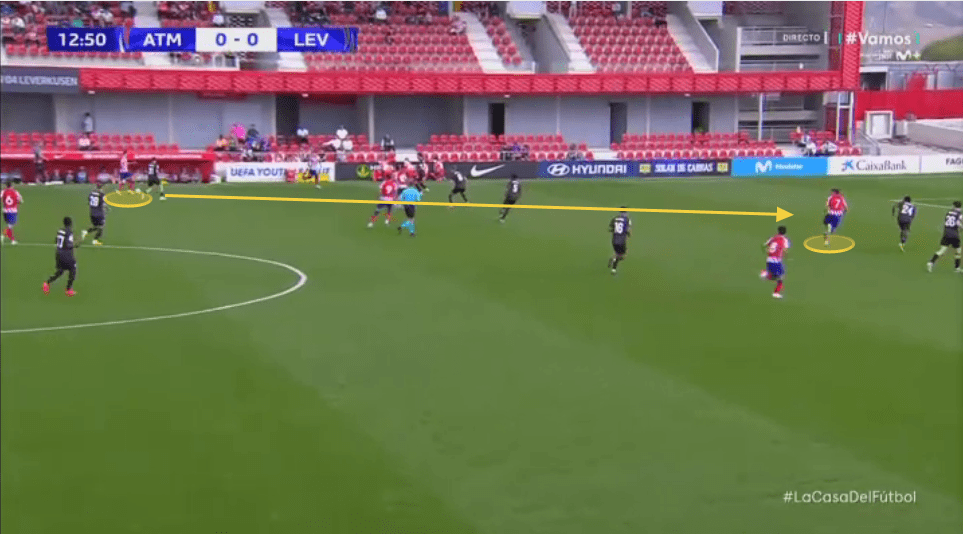
The open passes to the wing-backs, who are normally the widest when Atlético plays with a back-three, are a regular part of the team, given first by one of the central defenders.
Triangles are generated on the outside with the CB, the midfielder/inverted winger, and the wing-back, who always tries to generate 1-2 combinations and then goes out into space with great speed.
As long as things cannot happen inside, Atlético has vital and very useful mechanisms to go outside, with exchanges within midfielders and wingers so that they can advance outside with the wing-back.
They are very simple plays, but previously, it was a long wait to attract the pressure and move the rival block to throw the best pass to the best possible receiver.
In many matches, the communication between the same players and Fernando is heard, who normally asks to “run” when the time comes to launch those passes into space.
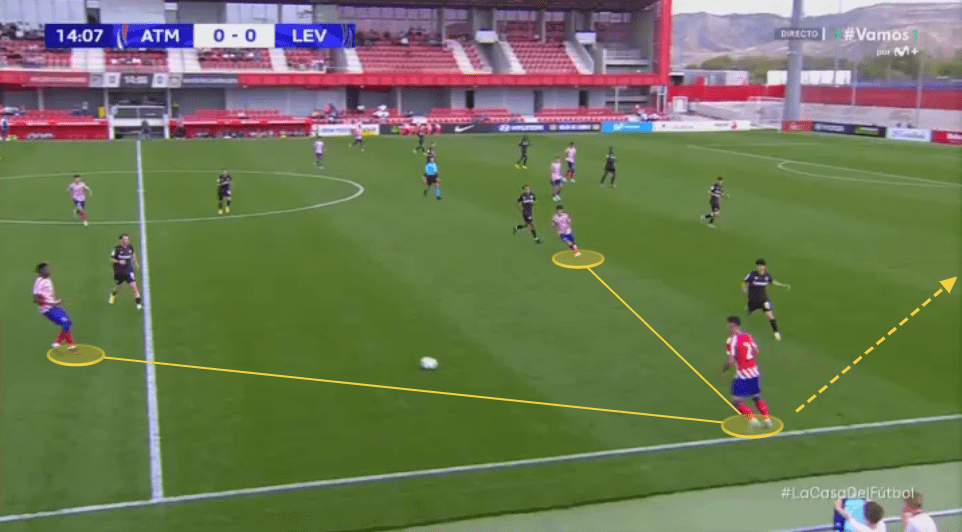
But one of the things that has certainly caught the eye is allowing their central defender, who sets up in the middle, the freedom to progress with his ball-carrying and even perform dismarking moves forward to generate new passing angles for his teammates.
When you play in a back three, things like that are possible, and it’s quite exciting to see how rotations between central defenders can happen, something coaches and teams don’t constantly perform in football.
It is not fully matured in the team but has been used more and more to eliminate the first pressure and generate angles to advance to the middle third.
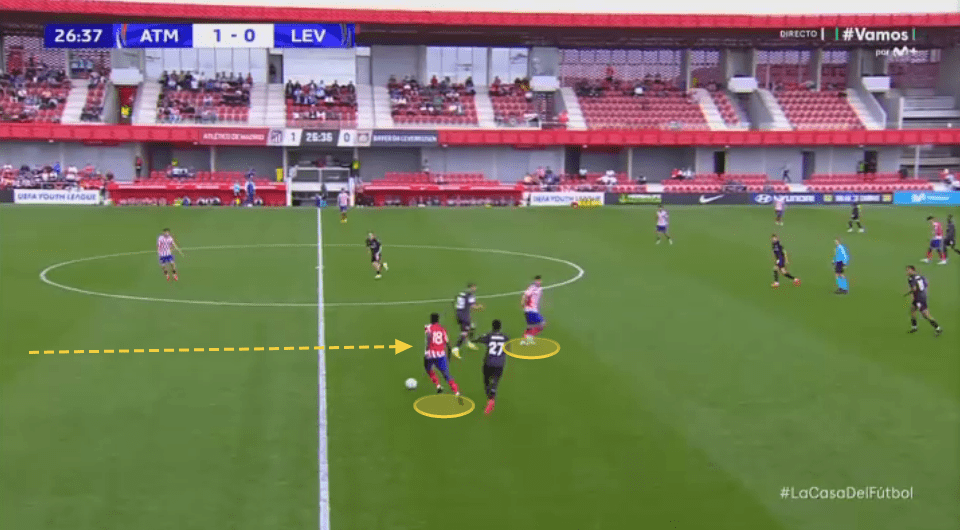
The use of the goalkeeper is another clear aspect of Torres’s tactics.
He plays with the ball at his feet, which is key to overcoming pressure and making direct passes that manage to turn the game around and run at high speed.
As we mentioned before, this team handles the idea of direct play in a Torres-esque way that is quite fun to watch.
Their build-up play is quick and the players understand their body postures to quickly move the game forward.
The important thing is that the first line of passing understands well this to attract, knowing that as soon as the pass progresses, chaos will be generated in seconds.
The goalkeeper, Alejandro Iturbe, has at least recently had some great games handling the ball, being a player who has understood the process of attracting and being a part of possessions especially when they are pressured higher up the pitch.
He knows when it is time to look for a long ball and a hold-up play from his striker, who has been important in the team, but also when he must remain calm and create passes that positively support ground build-ups, and he also has a very good fit when throwing a pass to the weak side for a wide player, be it with high passes or on the floor.
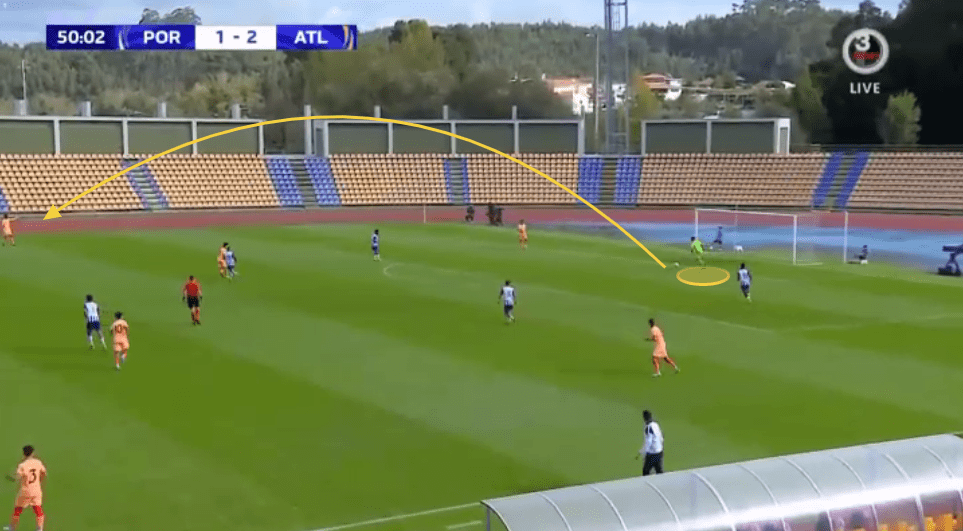
When Torres wants his team to generate in a back-four, he creates certain surprising movements for the rival, such as the rise of one of the full-backs, usually the left, which he sets as a winger in the upper part of the field, thus making one of the midfielders take place almost as a full-back in possession.
However, the idea is not that this movement happens at all.
The idea is to keep generating surprises for the rival, moving the ball more over the right, creating there, and then changing the ball to that side with an isolated player on the wing.
The similarities are great apart from this.
There is plenty of width among their first line of players, with one even leaving it, but one of the differences is that, in this case, three players act as midfielders in front of them.
Many of the movements sought in the attacking front involve the winger going inverted near the #9, creating plays between them.
One drops, asks for the ball, and drags a defender, while the other takes his spot and runs through the defender’s back.
The very high and open fullback allows this since the winger normally goes outside when they look to generate in a back four.
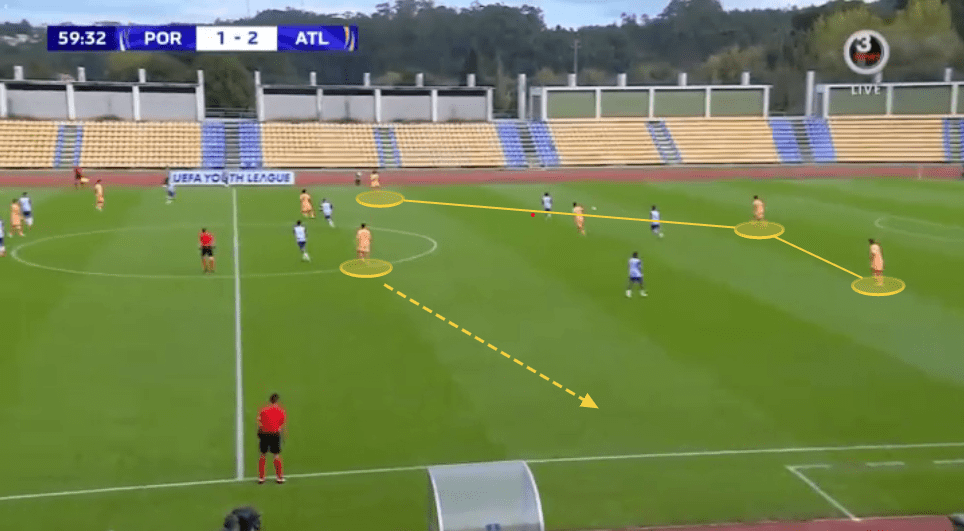
Conclusion
Fernando Torres style of play is still maturing, but he seems quite interesting and has a lot of potential for first-division football.
With a rather vertical and pragmatic defensive approach, Atlético de Madrid U19 manages rotations, positioning, and quite offensive and modern ideas in its approach to scoring goals.






Comments